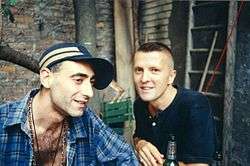Neue Deutsche Welle
Neue Deutsche Welle (NDW, pronounced [ˈnɔʏə ˈdɔʏtʃə ˈvɛlə], "New German Wave") is a genre of West German rock music originally derived from post-punk and new wave music with electronic influences.[1] The term was first coined by Dutch radio DJ Frits Spits on the popular nationwide radio station Hilversum 3, which was very popular among German listeners. Soon after that, the term was used in a record-shop advertisement by Burkhardt Seiler[2] in an August 1979 issue of the West German magazine Sounds. It was then used by journalist Alfred Hilsberg in an article about the movement titled "Neue Deutsche Welle — Aus grauer Städte Mauern" ("New German Wave — From Grey Cities' Walls") in Sounds in October 1979.[3]
| Neue Deutsche Welle | |
|---|---|
| Stylistic origins | |
| Cultural origins | Late 1970s, West Germany |
| Typical instruments | |
| Other topics | |
| |
History

The history of the Neue Deutsche Welle consists of two major parts. From its beginnings to 1981, the genre was mostly an underground movement with roots in British punk and new wave music. It quickly developed into an original and distinct style, influenced in no small part by the different sound and rhythm of the German language, which many of the bands had adapted from early on. Whilst some of the lyrics of artists like Nena and Ideal epitomized the zeitgeist of urban West Germany during the Cold War, others used the language in a surreal way, merely playing with its sound or graphic quality rather than using it to express meaning, as done by bands and artists such as Spliff, Joachim Witt and Trio.
The main centers of the NDW movement during these years were West Berlin, Düsseldorf, Hamburg, Hannover and Hagen, as well as, to a lesser extent, the Frankfurt Rhein-Main Region, Limburg an der Lahn and Vienna.
From about 1980 on, the music industry began noticing the Neue Deutsche Welle; however, because of the idiosyncratic nature of the music, focus shifted to creating new bands more compatible with the mainstream rather than promoting existing bands. Many one-hit wonders and short-lived bands appeared and were forgotten again in rapid succession. The overly broad application of the "NDW" label to these bands, as well as to almost any German musicians not using English lyrics, even if their music was apparently not influenced at all by the original NDW sound (including pure rock bands like BAP or even Udo Lindenberg), quickly led to the decay of the entire genre when many of the original musicians turned their backs in frustration.
Around 1983/1984, the era of the Neue Deutsche Welle came to an early end, following the oversaturation of the market with what was perceived as stereotypical, manufactured hits.
A revival of interest in the style in the Anglophone world occurred in 2003, with the release of DJ Hell's compilation New Deutsch.[4] The NDW has come to be acknowledged as a forerunner to later developments in dance-punk, electronic body music and electroclash.
In the 2000s, the term was used by the Berlin-based rap label Aggro Berlin to describe a supposed new German rap movement of which they claimed to be a part. This was the subject of Aggro artist Fler's 2005 single "Neue Deutsche Welle". The band Wir sind Helden was also influenced by the Neue Deutsche Welle.
References
- Nancy Kilpatrick, The Goth Bible: A Compendium for the Darkly Inclined, New York: St. Martin's Griffin, 2004, chapter 5, "Music of the Macabre," p. 84.
- Neue Deutsche Welle - Blog summary includes an image of the original advertisement published in Sounds 08/ 79.
- Neue Deutsche Welle - Aus grauer Städte Mauern (Sounds 10/ 79).
- Laurence Phelan, The Independent, August 31, 2003. Access date: July 22, 2008.